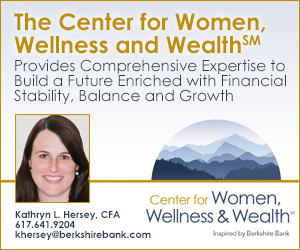
Spring and Summer Fitness
Q: I signed up for a coach-to-5K program now that there’s more daylight and I need to undo the weight I gained over the winter. I was instructed to buy a pair of running shoes, and when I went to buy them I was completely overwhelmed! How do I decide what’s best for me?
A: Great question! I agree; there are many choices and something as simple as buying footwear can be stressful! Many of my clients use three criteria for deciding: price point, aesthetics and comfort. While these are all factors to take into consideration, the number one deciding factor needs to be the design of the interior, the part that supports your foot, known as the “last” in shoe terminology. To decide which is right for your foot, consider these factors: heel drop; cushioning; weight of the sneaker which is important to the muscles of your lower leg; and most importantly for most women, support of the arch. Before going to purchase, you need to know whether you have a high, rigid arch, a neutral arch or a functionally falling arch (the arch flattens upon foot stride). You can evaluate this by wetting the bottom of your feet and taking a few jogging strides on a floor surface that will show your footprint. If you see a whole foot, you have a functionally falling (pronation) arch. If it has a cutout where the arch is, you have either a neutral or high arch. You can determine if it is a high arch by having someone watch you walk barefoot. If your arch doesn’t fall even a little when stepping, you have a high versus neutral arch. Pronating arches need a motion-control sneaker. Neutral arches need a neutral/stability sneaker and high arches need a cushioned sneaker. The chart illustrates my point.
Each major sneaker company has a variety of models of these three types. Once you know your type, you can use price point, aesthetics and feel to determine which shoe to buy, but you will know the category that’s right for your foot and use how they feel to determine the exact model.
Q: I am never going to be a runner, and the HIITS workouts just result in injury for me. Nevertheless, I need and want to start an exercise program that includes cardiovascular workouts to help me lose weight. What are my options?
A: You are smart to recognize that not everyone will do well on a running or HIITS workout program because of age, various joint/muscle contingencies, psychological aversion or other factors. Despite current in-vogue thinking, HIITS workouts are not the only way to lose weight! For many women, finding a mode of exercise that you enjoy, that doesn’t cause trauma and increase of the stress hormone cortisol, but that burns more calories than sitting on the couch, is the answer. Options that don’t include expensive equipment or that require time to get to a special facility are what many women are trying to identify.
My number one option for warmer weather that can be done outside is walking. Warmer weather and extended daylight hours make this exercise more realistic to fit into our schedules. When you pick up the pace and walk briskly for you, have purchased the correct sneakers and have access to a safe route, this is my number one choice! Second choice is indoor cardio machines that you can use at one of our many local gyms. Many women get bored or anxious trying to do an indoor workout that lasts more than ten minutes, so my solution for clients is to do five to ten minutes each on a treadmill, elliptical, arc trainer and/or bike. This routine provides a great cross-training workout, working a mixture of muscle groups in various positions while increasing breathing and heartrate, thereby increasing calorie burn, while minimizing the mental barriers to staying on a machine long enough to get a significant calorie expenditure. It’s 20 minutes that feel like 5 instead of 10 minutes that feel like 60!
Q: As the weather gets warmer and there are more hours of daylight, my cravings are changing. Are there foods that are better to eat in the spring/summer vs. the fall/winter?
A: Absolutely! We live in an era of importing and trucking food, but throughout most of human history we ate in harmony with what was locally and seasonally available. It’s my observation that when my clients eat out of harmony with the season, it leads to cravings and compulsive eating. It’s important from a weight management as well as an overall health perspective to try to eat with the seasons. Here are a few general guidelines as we transition from winter to spring and summer in our geographic location.
In cold weather, heavier foods and foods that are cooked are better choices: root vegetables such as sweet potatoes, beets, parsnips and carrots; and winter squash such as butternut are good choices. As the weather warms, heavier root vegetables are replaced with leafy greens, tomatoes, zucchini, yellow squash and cucumbers, all of which have higher water content and are lighter in the GI tract. Raw foods are more desirable to eat in the warmer months because they help to keep our internal temperature from overheating when the weather is hot. Crock pot meals, soups and nurturing meals such as meatloaf and macaroni and cheese sound and feel good to eat in the winter months yet in the summer are less appealing, whereas lightly blanched stir-fry meals, salads and lighter proteins such as white fish with grilled vegetables eaten in the summer hit the spot. Salad for dinner may sound like a good weight control choice, but in the winter it may lead to a cookie binge an hour later because salads are too light for cold-weather months. Moving into spring, transition to more salads, lighter proteins such as white fish and eggs as main meal choices, higher water content foods that are not cooked such as fruits and vegetables from farmers’ markets or local CSAs. Cold soups and one-dish meals that are cool, such as gazpacho, cold tomato or cucumber soups with shrimp or tuna tartare, also make great spring and summer meals in harmony with the upcoming season! ■
Written by: Judy Torel
Judy Torel, owner of Judy Torel Fitness, is degreed, certified and credentialed in every discipline involved in changing habits that result in body changes. She holds certification through ACSM as an Exercise Specialist, nutrition certification through HealthExcel and a master’s degree from UAlbany in counseling psychology with a specialty in addictive behaviors. Judy is also a certified yoga instructor through Yoga Alliance and teaches meditation, breathing and physical yoga practice for stress and anxiety management. As a seven-time Ironman triathlete, she has dedicated her life to sharing the knowledge she has ascertained through her own experiences. Visit judytorel.com or call 518-469-0815 for more information about classes and her studio.









